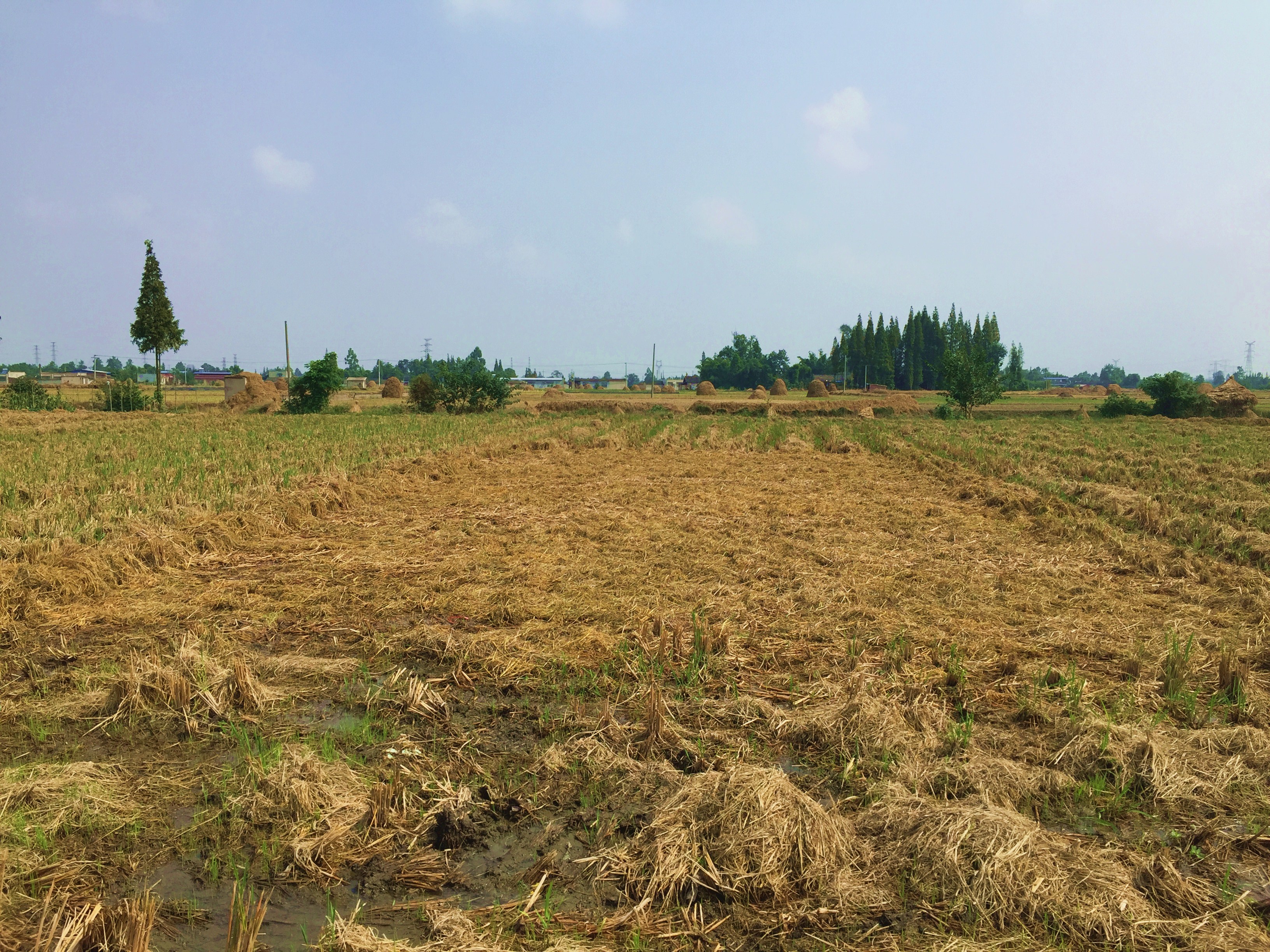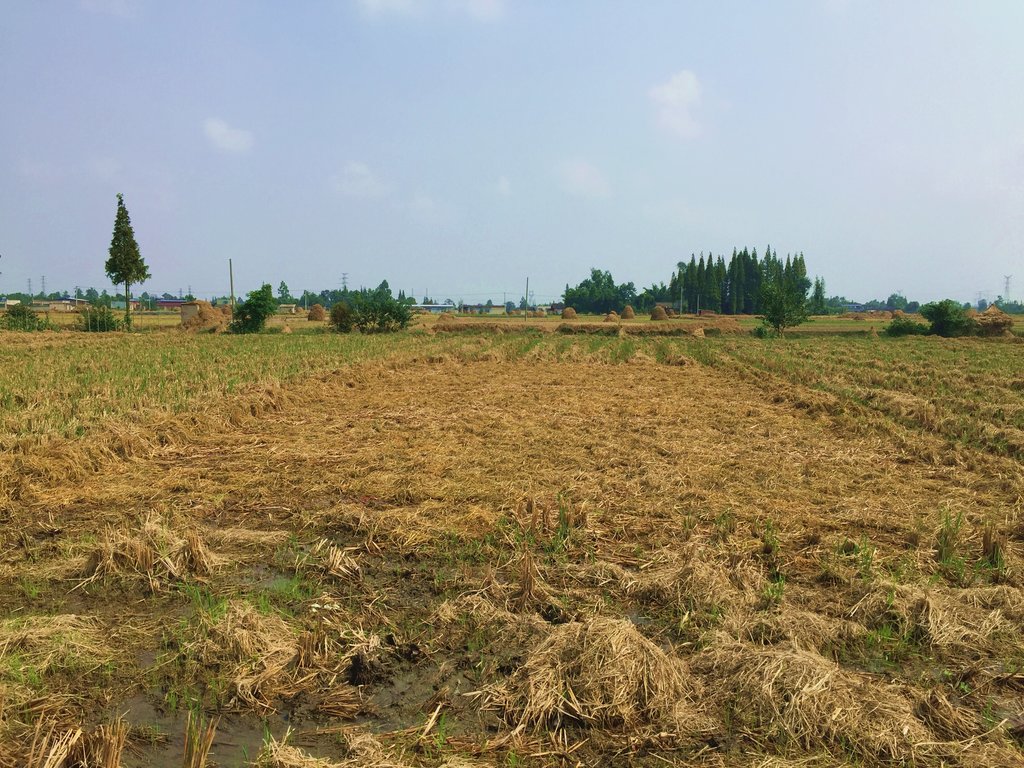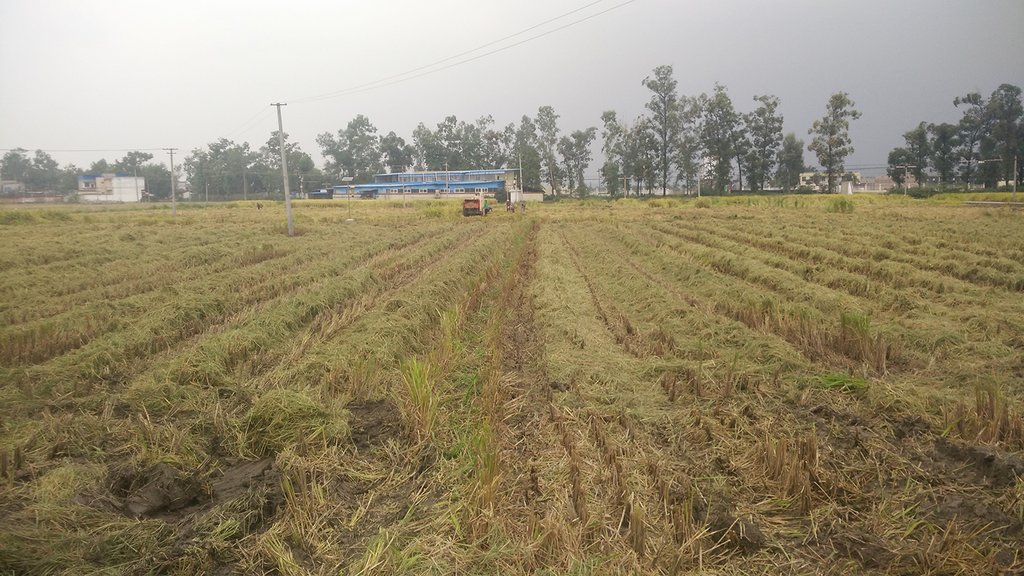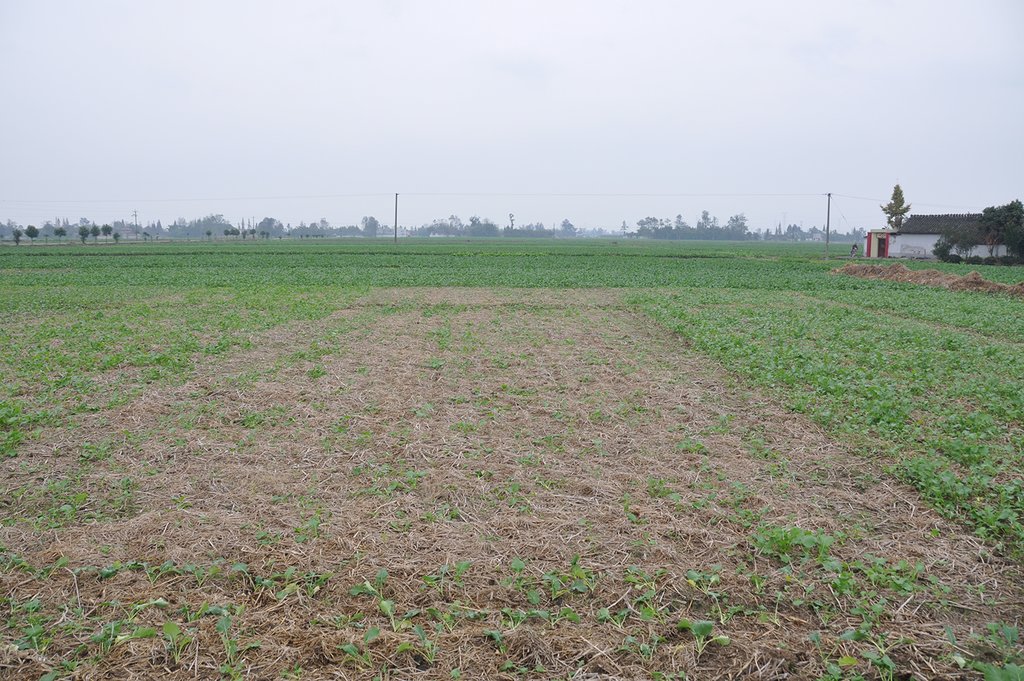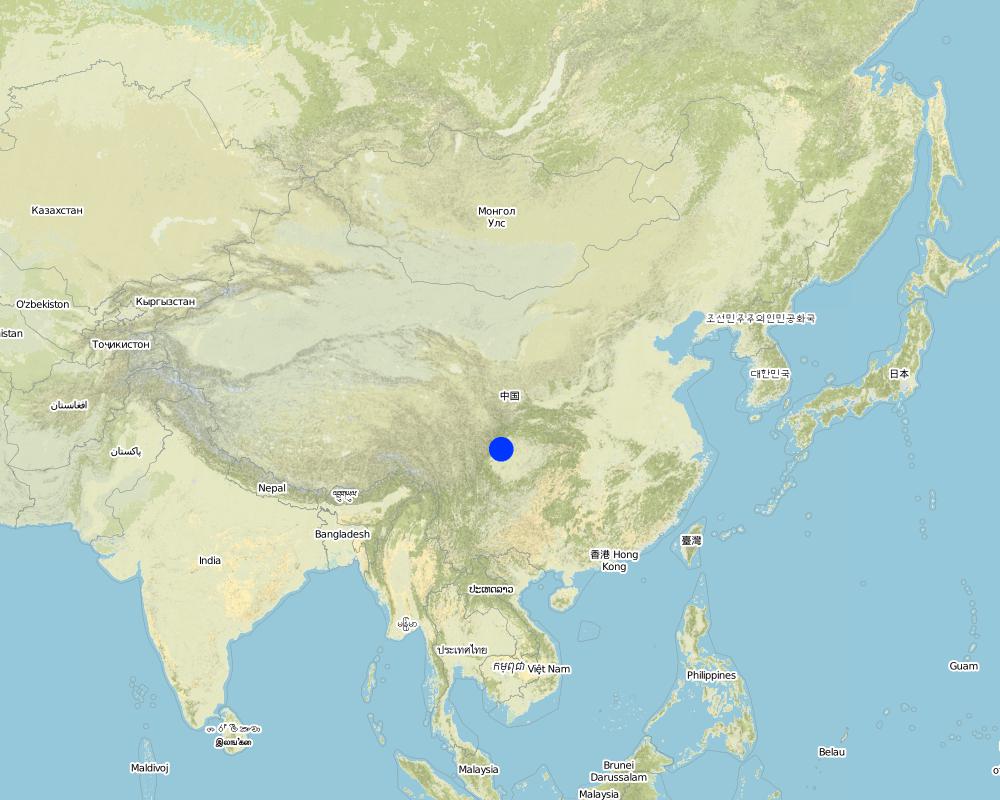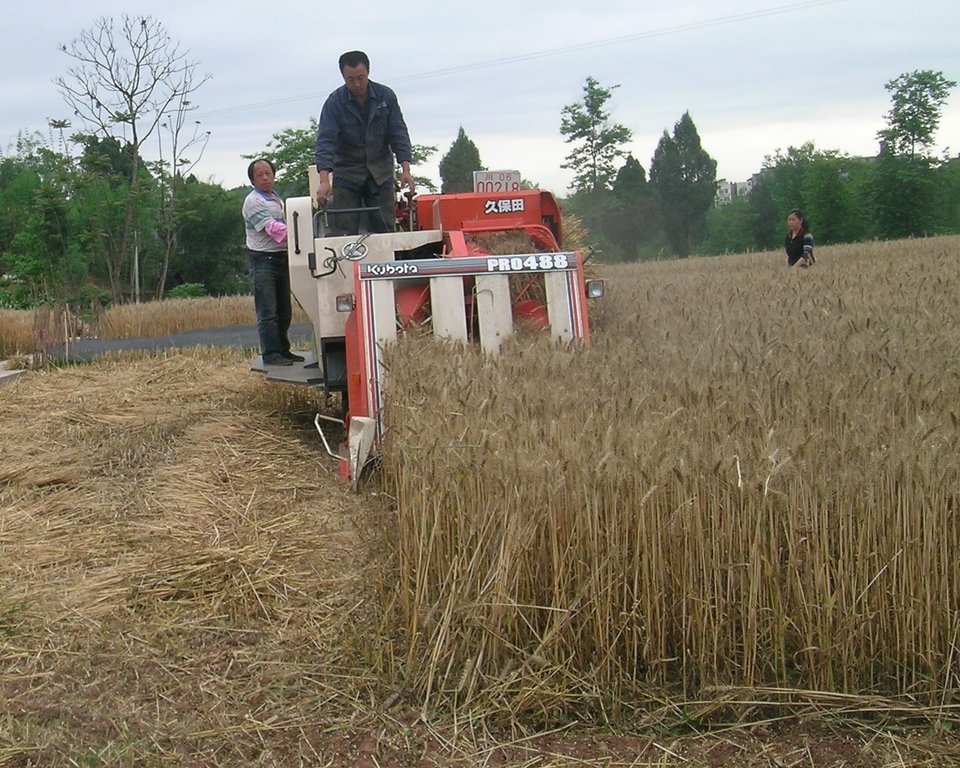Straw residues left on field after harvest and no tillage [China]
- Creación:
- Actualización:
- Compilador: Song Guo
- Editor: –
- Revisores: Gudrun Schwilch, Ursula Gaemperli, Alexandra Gavilano
No tillage planting
technologies_3239 - China
Visualizar secciones
Expandir todo Colapsar todos1. Información general
1.2 Detalles de contacto de las personas de referencia e instituciones involucradas en la evaluación y la documentación de la Tecnología
Persona(s) de referencia clave
Especialista MST:
Hongzhu Fan
Soil and Fertilizer Institute of the Sichuan Academy of Agricultural Sciences
China
usuario de la tierra:
Wu Shengde
China
Nombre del proyecto que financió la documentación/ evaluación de la Tecnología (si fuera relevante)
Interactive Soil Quality assessment in Europe and China for Agricultural productivity and Environmental Resilience (EU-iSQAPER)Nombre de la(s) institución(es) que facilitaron la documentación/ evaluación de la Tecnología (si fuera relevante)
‒ Soil and Fertilizer Institute of the Sichuan Academy of Agricultural Sciences (SFI) - China1.3 Condiciones referidas al uso de datos documentados mediante WOCAT
El compilador y la/s persona(s) de referencia claves aceptan las condiciones acerca del uso de los datos documentados mediante WOCAT:
Sí
1.4 Declaración de la sostenibilidad de la Tecnología descrita
¿La Tecnología aquí descrita resulta problemática en relación a la degradación de la tierra, de tal forma que no puede considerársela una tecnología sostenible para el manejo de la tierra?
No
2. Descripción de la Tecnología MST
2.1 Breve descripción de la Tecnología
Definición de la Tecnología:
Method of this agricultual technology the rice straw will be left on the field after mechanized harvesting. Succession crop, such as rape, wheat or potato, were seeded directly under no tillage condition. Both measures aim at better soil regeneration and soil conditions for agriculture and subsequently increased yield and less soil degradation.
2.2 Descripción detallada de la Tecnología
Descripción:
The SLM practice (straw mulching and no tillage) is applied in the Chengdu Plain Paddy Soil. The Chengdu plain has mild climate and abundant rainfall. It belongs to the warm humid subtropical Pacific monsoon climate zone.The main types of soil in the Chengdu plain are paddy soil and purple soil.The total land resources of the Chengdu plain are 1331800 hectares, and the per capita land resources are about 0.1044 hectares per person. In 2010, the total amount of cultivated land in the Chengdu plain was 478069 hectares, accounting for 35.90% of the area of the plain, accounting for 42.36% of the total area of agricultural land in the region, and the per capita arable land area was only about 0.0375 hectares. The Chengdu Plain is an important grain production base in Sichuan. Rice field-upland field rotation (rice - wheat, rice - rapeseed) is an important agricultural system.
On the case study area, the N, P and K fertilizers were applied as urea, calcium superphosphate and potassium chloride at the rates of 120-150 kg N ha-1, 75-120 kg P2O5 ha-1,and 75-120 kg K2O ha-1, during every crop. During crop season, the rate of 60% of N, 100% of P, and 50% of K fertilizers were applied as base fertilizer, while remaining 40% of N and 50% of K were used as top dressing fertilizer. The main measures of this SLM is rice straw or wheat straw mulching while havesting (leaving the straw after havest scattered on the field). Crops were harvested by a combine harvester (Kuotian combine harvester, model PR0488), then straw and stubble of crops were left at size of less than 20 cm in the field. The seeding of succession crop such as wheat and oil seed rape is done by a direct seeding machine. The land users are working eighter with a contractor or they use their own machines and labour force. The purposes of this technology were to increase production and improve soil fertility. Although plough layer can become shallow by long-term no tillage cultivation, more and more land users like this technology because it promises increased grain yield, reduction of fertilizers (and subsequently cost), and it improves soil physical, chemical and biological properties of soil. Thus, it is expected that the measures of this SLM-Technology ends up in improved soil moisture, higher diversity of soil life and finally soil fertility .
2.3 Fotografías de la Tecnología
2.5 País/ región/ lugares donde la Tecnología fue aplicada y que se hallan comprendidos por esta evaluación
País:
China
Región/ Estado/ Provincia:
Basin plain, Chengdu, Sichuan
Especifique más el lugar :
Guanhan City, Wenjiang District, Chongzhou City
Especifique la difusión de la Tecnología:
- distribuida parejamente sobre un área
Si se desconoce el área precisa, indique el área aproximada cubierta:
- 100-1,000 km2
Comentarios:
This long-term straw mulch experiment was started in the 2005. This site is situated in subtropical monsoon region with anverage annual temperature of about 16.3℃, 281 days frost free. Annual precipitation is about 890mm.
Map
×2.6 Fecha de la implementación
Si no se conoce el año preciso, indique la fecha aproximada:
- 10-50 años atrás
2.7 Introducción de la Tecnología
Especifique cómo se introdujo la Tecnología:
- durante experimentos/ investigación
Comentarios (tipo de proyecto, etc.):
The current case study bases only on a test area within the scope of the iSQAPER Project. A long-term straw mulch and fertilization experiment was initiated in 2005 at Sichuan Academy of Agricultural Sciences Soil and Fertilizer Research Institute’s Guanghan agricultural experiment station in Sichuan province, southwest China. Thus, effects of long-term fertilization and straw much on crop yields, soil physical and chemical properties under rice-rapeseed rotation were assessed in a paddy soil
3. Clasificación de la Tecnología MST
3.1 Propósito(s) principal(es) de la Tecnología MST
- mejorar la producción
- reducir, prevenir, restaurar la degradación del suelo
- conservar el ecosistema
- preservar/ mejorar biodiversidad
3.2 Tipo(s) actuales de uso de la tierra donde se aplica la Tecnología

Tierras cultivadas
- Cosecha anual
Cosechas anuales - Especifique cultivos:
- cultivos de semillas oleaginosas - girasol, colza, otros
- wheat, rice
Número de temporadas de cultivo por año:
- 2
¿Se practica la rotación de cultivos?
Sí
Si fuera el caso, especifique :
Method of this agricultual technology the rice straw will be left on the field after mechanized harvesting. Succession crop, such as rape, wheat or potato, were seeded directly under no tillage condition.
3.4 Provisión de agua
Provisión de agua para la tierra donde se aplica la Tecnología:
- mixta de secano – irrigada
3.5 Grupo MST al que pertenece la Tecnología
- sistemas de rotación (rotación de cosecha, cosecha rotatoria con descanso, agricultura migratoria)
- cobertura de suelo/ vegetal mejorada
- perturbación mínima del suelo
3.6 Medidas MST que componen la Tecnología

medidas agronómicas
- A1: vegetación/ cubierta del suelo
- A2: materia orgánica/ fertilidad del suelo
- A3: Tratamiento de superficie del suelo
3.7 Principales tipos de degradación del suelo encarados con la Tecnología

deterioro químico del suelo
- Cn: reducción de la fertilidad y contenido reducido de la materia orgánica del suelo (no ocasionados por la erosión)

deterioro físico del suelo
- Pc: compactación
- Pk: desmoronamiento y encostramiento
3.8 Prevención, reducción o restauración de la degradación del suelo
Especifique la meta de la Tecnología con relación a la degradación de la tierra:
- prevenir la degradación del suelo
4. Especificaciones técnicas, actividades de implementación, insumos y costos
4.1 Dibujo técnico de la Tecnología
Especificaciones técnicas (relacionadas al dibujo técnico):
The SLM practice (straw mulching while harvesting and no tillage) is applied in the Chengdu Plain paddy soil. The main measures of this SLM method is straw mulching while harvesting and no tillage. Crops are harvested by machine (actually in this case study by Kuotian combine harvester/model was PR0488), and then straw and stubble were left at size of less than 20 cm on the soil surface. The N, P and K fertilizers to the succession crop were applied in form of urea, calcium superphosphate and potassium chloride at the rates of 120-150 kg N ha-1, 75-120 kg P2O5 ha-1, and 75-120 kg K2O ha-1. Rates of 60% of N, 100% of P and 50% of K fertilizers were applied as base fertilizers, while the remaining 40% of N and 50% of K were used as top dressing fertilizers. After previous crop harvest of rice the succession crop as for example wheat, oil rape, maize will be seeded directly under no tillage condition.
Autor:
Hongzhu Fan
Fecha:
30/10/2017
4.2 Información general sobre el cálculo de insumos y costos
Especifique cómo se calcularon los costos e insumos:
- por área de Tecnología
Indique tamaño y unidad de área:
1 hectare
otra / moneda nacional (especifique):
Renminbi (RMB)
Si fuera relevante, indique la tasa de cambio de dólares americanos a la moneda local (ej. 1 U$ = 79.9 Reales Brasileros): 1 U$ =:
6,6
Indique el costo promedio del salario de trabajo contratado por día:
120 RMB per day
4.5 Actividades de establecimiento/ recurrentes
| Actividad | Momento/ frequencia | |
|---|---|---|
| 1. | mechanized harvesting | August or September |
| 2. | spreading the straw residues after havest on the field | after harvest of crops |
| 3. | fertilization | October |
| 4. | no tillage and direct seeding | October |
4.6 Costos e insumos necesarios para actividades de mantenimiento/ recurrentes (por año)
| Especifique insumo | Unidad | Cantidad | Costos por unidad | Costos totales por insumo | % de los costos cubiertos por los usuarios de las tierras | |
|---|---|---|---|---|---|---|
| Mano de obra | All reccurent labour (above) is done within the familiy* | person-day | 0,5 | 120,0 | 60,0 | 100,0 |
| Equipo | harvester (machine from contractor without labour force)* | ha | 1,0 | 3000,0 | 3000,0 | 100,0 |
| Equipo | Direct seeding machine (from contractor without labour force)* | ha | 1,0 | 1800,0 | 1800,0 | |
| Material para plantas | seed (weat, rape) | kg | 120,0 | 2,0 | 240,0 | 100,0 |
| Fertilizantes y biocidas | urea | kg | 280,0 | 3,0 | 840,0 | 100,0 |
| Fertilizantes y biocidas | calcuim superphosphate | kg | 810,0 | 1,0 | 810,0 | 100,0 |
| Fertilizantes y biocidas | potassium chloride | kg | 200,0 | 3,5 | 700,0 | 100,0 |
| Indique los costos totales para mantenecer la Tecnología | 7450,0 | |||||
| Costos totales para mantener la Tecnología en USD | 1128,79 | |||||
Comentarios:
*The labour (for harvesting, fertilizering and seeding ) is unpaid when those were done by farm familiy.
But in China, there is no contractor to do all work (for harvesting, fertilizing and seeding). If all works done by a contractor, farms will give up planting crops. Usually, a contractor provide machine to farm, but no labor. Farm members engaged in agricultural production will do most of the work by themselves in order to save cost.
4.7 Factores más determinantes que afectan los costos:
Describa los factores más determinantes que afectan los costos:
Most of important factor affecting the costs of this technology is the type of machine used for harvest. (E.g. cost is high by the mini combine harvester because of the low efficiency).
5. Entorno natural y humano
5.1 Clima
Lluvia anual
- < 250 mm
- 251-500 mm
- 501-750 mm
- 751-1,000 mm
- 1,001-1,500 mm
- 1,501-2,000 mm
- 2,001-3,000 mm
- 3,001-4,000 mm
- > 4,000 mm
Zona agroclimática
- Sub-húmeda
5.2 Topografía
Pendientes en promedio:
- plana (0-2 %)
- ligera (3-5%)
- moderada (6-10%)
- ondulada (11-15%)
- accidentada (16-30%)
- empinada (31-60%)
- muy empinada (>60%)
Formaciones telúricas:
- meseta/ planicies
- cordilleras
- laderas montañosas
- laderas de cerro
- pies de monte
- fondo del valle
Zona altitudinal:
- 0-100 m s.n.m.
- 101-500 m s.n.m.
- 501-1,000 m s.n.m
- 1,001-1,500 m s.n.m
- 1,501-2,000 m s.n.m
- 2,001-2,500 m s.n.m
- 2,501-3,000 m s.n.m
- 3,001-4,000 m s.n.m
- > 4,000 m s.n.m
Indique si la Tecnología se aplica específicamente en:
- no relevante
5.3 Suelos
Profundidad promedio del suelo:
- muy superficial (0-20 cm)
- superficial (21-50 cm)
- moderadamente profunda (51-80 cm)
- profunda (81-120 cm)
- muy profunda (>120 cm)
Textura del suelo (capa arable):
- mediana (limosa)
Textura del suelo (> 20 cm debajo de la superficie):
- áspera/ ligera (arenosa)
Materia orgánica de capa arable:
- media (1-3%)
Si se halla disponible, adjunte una descripción completa de los suelos o especifique la información disponible, por ej., tipo de suelo, pH/ acidez de suelo, capacidad de intercambio catiónico, nitrógeno, salinidad, etc. :
Soil type is alluvial soil, PH is 5.5, SOC 31.3g/kg, N 2.02g/kg,P 1.04g/kg, K 7.69g/kg, available nitrogen 189.7mg/kg, available phosphorus 12.6mg/kg, ammonium acetate extractable potassium95.5mg/kg.
5.4 Disponibilidad y calidad de agua
Agua subterránea:
< 5 m
Disponibilidad de aguas superficiales:
mediana
Calidad de agua (sin tratar):
agua potable de buena calidad
¿La salinidad del agua es un problema?
No
¿Se está llevando a cabo la inundación del área? :
No
5.5 Biodiversidad
Diversidad de especies:
- elevada
Diversidad de hábitats:
- elevada
5.6 Las características de los usuarios de la tierra que aplican la Tecnología
Sedentario o nómada:
- Sedentario
Orientación del mercado del sistema de producción:
- mixta (subsistencia/ comercial)
Ingresos no agrarios:
- menos del 10% de todos los ingresos
Nivel relativo de riqueza:
- promedio
Individuos o grupos:
- grupos/ comunal
Nivel de mecanización:
- mecanizado/motorizado
Género:
- mujeres
Edad de los usuarios de la tierra:
- personas de mediana edad
5.7 Área promedio de la tierra usada por usuarios de tierra que aplican la Tecnología
- < 0.5 ha
- 0.5-1 ha
- 1-2 ha
- 2-5 ha
- 5-15 ha
- 15-50 ha
- 50-100 ha
- 100-500 ha
- 500-1,000 ha
- 1,000-10,000 ha
- > 10,000 ha
¿Esto se considera de pequeña, mediana o gran escala (refiriéndose al contexto local)?
- escala mediana
5.8 Tenencia de tierra, uso de tierra y derechos de uso de agua
Tenencia de tierra:
- estado
Derechos de uso de tierra:
- comunitarios (organizado)
Derechos de uso de agua:
- comunitarios (organizado)
Comentarios:
In China, land ownership belongs to the state, but land use rights belong to farm. In other words, farm can decide to plant rice, wheat, or fruit tree in the land, but the farm cannot sell this land.
5.9 Acceso a servicios e infraestructura
salud:
- pobre
- moderado
- bueno
educación:
- pobre
- moderado
- bueno
asistencia técnica:
- pobre
- moderado
- bueno
empleo (ej. fuera de la granja):
- pobre
- moderado
- bueno
mercados:
- pobre
- moderado
- bueno
energía:
- pobre
- moderado
- bueno
caminos y transporte:
- pobre
- moderado
- bueno
agua potable y saneamiento:
- pobre
- moderado
- bueno
servicios financieros:
- pobre
- moderado
- bueno
6. Impactos y comentarios para concluir
6.1 Impactos in situ demostrados por la Tecnología
Impactos socioeconómicos
Producción
producción de cultivo
Cantidad antes de MST:
14.9 t ha-1*
Cantidad luego de MST:
15.5 t ha-1*
Comentarios/ especifique:
* yield for rape
Wheat yield were 6.3 t ha-1 before SLM and 6.7 t ha-1 after SLM, respectively. Rice yield were 8.6 t ha-1 before SLM and 8.8 t ha-1 after SLM, respectively.
manejo de tierras
Comentarios/ especifique:
No tillage is an important way to reduce cost by machine plough field. Less fertilizing work and amount of fertilizers by leaving straw on field (straw contains a large amount of C, N, P, and K)
Disponibilidad y calidad de agua
demanda de agua para irrigar
Comentarios/ especifique:
Straw mulching can decreased demand for irrigation water, because water can be keep in the straw, and straw mulching on the soil also can reduced evaporation of water.
Ingreso y costos
gastos en insumos agrícolas
Comentarios/ especifique:
No tillage is an important way to reduce cost by machine plough field. Less fertilizing work and amount of fertilizers by straw return compared with no straw mulching (straw contains a large number of C, N, P and K. Therefore agricultural inputs can be reduced.
ingreso agrario
Comentarios/ especifique:
Do to better yield and reduction of costs.
carga de trabajo
Impactos socioculturales
MST/ conocimiento de la degradación del suelo
Comentarios/ especifique:
Increased knowledge on the benefits of straw mulching by the land users.
Impactos ecológicos
Suelo
humedad del suelo
Comentarios/ especifique:
Due to straw mulching, because the water can be kept in the straw and soil evaporation can be reduced to improved oil cover.
cubierta del suelo
Comentarios/ especifique:
Due to the mulching by straw, the soil remain covered practically the whole year round.
encostramiento/ sellado de suelo
Comentarios/ especifique:
Without ploughing the soil crusting can occur at long term use of the technology (findings from a long-term straw mulch and fertilization experiment was initiated in 2005 at Sichuan Academy of Agricultural Sciences Soil and Fertilizer Research Institute’s Guanghan agricultural experiment station in Sichuan province)
compactación de suelo
Comentarios/ especifique:
Without ploughing the soil gets more compact at long term use of the technology (findings from a long-term straw mulch and fertilization experiment was initiated in 2005 at Sichuan Academy of Agricultural Sciences Soil and Fertilizer Research Institute’s Guanghan agricultural experiment station in Sichuan province)
ciclo/ recarga de nutrientes
materia orgánica debajo del suelo C
Comentarios/ especifique:
Due to mulching by rice straw (crop residues)
Biodiversidad: vegetación, animales
biomasa/ sobre suelo C
Comentarios/ especifique:
Due to mulching by rice straw (crop residues)
diversidad animal
Comentarios/ especifique:
Due to mulching by rice straw (crop residues), soil life has increased.
especies benéficas
Reducción de riesgos de desastres y riesgos climáticos
emisión de carbono y gases de invernadero
Comentarios/ especifique:
Traditional burning of rice straw on the fields has been reduced, as straw is needed for mulching. Subsequently the C can be bound within the soil and will not be emitted into the air in form of CO2.
6.2 Impactos fuera del sitio demostrados por la Tecnología
impacto de gases de invernadero
Comentarios/ especifique:
Traditional burning of rice straw on the fields has been reduced, as straw is needed for mulching. Subsequently the C can be bound within the soil and will not be emitted into the air in form of CO2.
6.4 Análisis costo-beneficio
¿Cómo se comparan los beneficios con los costos de mantenimiento/ recurrentes (desde la perspectiva de los usuarios de tierra)?
Ingresos a corto plazo:
ligeramente positivo
Ingresos a largo plazo:
positivo
6.5 Adopción de la Tecnología
- 11-50%
De todos quienes adoptaron la Tecnología, ¿cuántos lo hicieron espontáneamente, por ej. sin recibir nada de incentivos/ materiales:
- 91-100%
6.6 Adaptación
¿La tecnología fue modificada recientemente para adaptarse a las condiciones cambiantes?
No
6.7 Fuerzas/ ventajas/ oportunidades de la Tecnología
| Fuerzas/ ventajas/ oportunidades desde la perspectiva del usuario de la tierra |
|---|
| This technology can improve the yield |
| It can save labour by leaving straw on the field |
| Fuerzas/ ventajas/ oportunidades desde la perspectiva del compilador o de otra persona de referencia clave |
|---|
| Straw mulching can increase the soil carbon input, and improve the soil quantity. |
| This technology can reduce land degradation. |
6.8 Debilidades/ desventajas/ riesgos de la Tecnología y formas de sobreponerse a ellos
| Debilidades/ desventajas/ riesgos desde la perspectiva del usuario de la tierra | ¿Cómo sobreponerse a ellas? |
|---|---|
| Soil structure was deteriorated by no tillage cultivation. | tillage |
| Debilidades/ desventajas/ riesgos desde la perspectiva del compilador o de otra persona de referencia clave | ¿Cómo sobreponerse a ellas? |
|---|---|
| Soil hardening occured, and also a thin impervious layer was built at the soil surface | It could be good to plough up the soil after an interval of 5 years |
| Obstruction of rainwater infiltration | |
| Soil plough layer becomes shallow |
7. Referencias y vínculos
7.1 Métodos/ fuentes de información
- entrevistas con usuarios de tierras
94 people
- compilación de informes y otra documentación existente
¿Cuándo se compilaron los datos (en el campo)?
20/09/2016
7.2 Vínculos a las publicaciones disponibles
Título, autor, año, ISBN:
Composition of Wheat Rhizosphere Antagonistic Bacteria and Wheat Sharp Eyespot as Affected by Rice Straw Mulching. CHEN Huai-Gu, CAO Qi-Guang, XIONG Gui-Lin, LI Wei, ZHANG Ai-Xiang, YU Han-Shou and WANG Jin-Sheng.2010.
¿Dónde se halla disponible? ¿Costo?
ScienceDirect. No
Título, autor, año, ISBN:
Effects of pre-sowing irrigation and straw mulching on the grain yieldand water use efficiency of summer maize in the North China Plain. Zhenxing Yan, Chao Gao, Yujie Ren, Rui Zong, Yuzhao Ma, Quanqi Li. 2017
¿Dónde se halla disponible? ¿Costo?
ScienceDirect. No
Título, autor, año, ISBN:
Effects of snow cover plus straw mulching on microorganisms in paddy soil during winter.Hao Zhanga,b, Jie Tanga, Shuang Liang.2017
¿Dónde se halla disponible? ¿Costo?
ScienceDirect. No
Título, autor, año, ISBN:
Effects of Non-flooded Cultivation with Straw Mulching on Rice Agronomic Traits and Water Use Efficiency. QIN Jiang-tao , HU Feng , LI Hui-xin , WANG Yi-ping , HUANG Fa-quan , HUANG Hua-xiang.2006
¿Dónde se halla disponible? ¿Costo?
ScienceDirect. No
Título, autor, año, ISBN:
Growth Characteristics and Yield of Late-Season Rice under No-tillageand Non-flooded Cultivation with Straw Mulching. WANG Dong, LI Hui-xin, QIN Jiang-tao, LI Da-ming, HU Feng.2010
¿Dónde se halla disponible? ¿Costo?
ScienceDirect. No
Título, autor, año, ISBN:
Impact of tillage practices on soil bacterial diversity and composition under the tobacco-rice rotation in China. Yanping Lei, Yongliang Xiao, Lifeng Li,Chaoqiang Jiang, Chaolong Zu, Tian Li, and Hui Cao.2017
¿Dónde se halla disponible? ¿Costo?
ScienceDirect. No
Título, autor, año, ISBN:
Nutrient Decomposition Rate and Sugarcane Yield as Influenced by Mung Bean Intercropping and Crop Residue Recycling Tie-Guang He,Li-Rong Su,Yang-Rui Li,Tian-Ming Su2 Fang Qin,Qin Li.2017
¿Dónde se halla disponible? ¿Costo?
ScienceDirect. No
Título, autor, año, ISBN:
Process rates of nitrogen cycle in uppermost topsoil after harvesting in no-tilled and ploughed agricultural clay soil. Merjo Laine . Tobias Ru¨ tting . Laura Alakukku . Ansa Paloja¨rvi . Rauni Stro¨mmer.2017
¿Dónde se halla disponible? ¿Costo?
ScienceDirect. No
Título, autor, año, ISBN:
Research on the effect of straw mulching on the soil moisture by field experiment in the piedmont plain of the Taihang Mountains. LI Man, ZHANG Wei, HE Yu-jiang, WANG Gui-ling.2017
¿Dónde se halla disponible? ¿Costo?
ScienceDirect. No
Título, autor, año, ISBN:
Rice–wheat cropping system: tillage, mulch, and nitrogen effects on soil carbon sequestration and crop productivity Keshav R. Adhikari,Khem R. Dahal,Zueng-Sang Chen,Yih-Chi Tan,Jihn-Sung Lai.2017
¿Dónde se halla disponible? ¿Costo?
ScienceDirect. No
Título, autor, año, ISBN:
Soil Carbon Sequestration and Crop Yields in Rice–Wheat and Sugarcane–Ratoon–Wheat Cropping Systems Through Crop Residue Management and Inoculation of Trichoderma viride in Subtropical India.S. K. Shukla,Swaha Shee,S. K. Maity,S. Solomon,S. K. Awasthi,Asha Gaur,A. D. Pathak,V. P. Jaiswal.2017
¿Dónde se halla disponible? ¿Costo?
ScienceDirect. No
Título, autor, año, ISBN:
成都平原麦稻双免耕秸秆还田技术模式.汤永禄 , 黄钢, 郑家国, 李朝苏,邓先和,付书明.2008
¿Dónde se halla disponible? ¿Costo?
http://www.cnki.net/. No
Título, autor, año, ISBN:
Influence of straw mulching with no-till on soil nutrients and carbon pool management index.CHEN Shang-hong, ZHU Zhong-lin, LIU Ding-hui, SHU Li , WANG Chang-quan.2008
¿Dónde se halla disponible? ¿Costo?
http://www.cnki.net/. No
7.3 Vínculos a la información relevante disponible en línea
Título/ descripción:
Effects of pre-sowing irrigation and straw mulching on the grain yieldand water use efficiency of summer maize in the North China Plain.
URL:
http://dx.doi.org/10.1016/j.agwat.2017.02.017
Título/ descripción:
Effects of snow cover plus straw mulching on microorganisms in paddy soil during winter
URL:
http://dx.doi.org/10.1016/j.apsoil.2017.05.023
Título/ descripción:
Growth Characteristics and Yield of Late-Season Rice under No-tillageand Non-flooded Cultivation with Straw Mulching
URL:
DOI: 10.1016/S1672-6308(08)60117-1
Título/ descripción:
Impact of tillage practices on soil bacterial diversity and composition under the tobacco-rice rotation in China
URL:
DOI 10.1007/s12275-017-6242-9
Título/ descripción:
Nutrient Decomposition Rate and Sugarcane Yield as Influenced by Mung Bean Intercropping and Crop Residue Recycling
URL:
DOI 10.1007/s12355-017-0548-0
Título/ descripción:
Process rates of nitrogen cycle in uppermost topsoil after harvesting in no-tilled and ploughed agricultural clay soil
URL:
DOI 10.1007/s10705-017-9825-2
Título/ descripción:
Rice–wheat cropping system: tillage, mulch, and nitrogen effects on soil carbon sequestration and crop productivity
URL:
DOI 10.1007/s10333-015-0511-1
Título/ descripción:
Soil Carbon Sequestration and Crop Yields in Rice–Wheat and Sugarcane–Ratoon–Wheat Cropping Systems Through Crop Residue Management and Inoculation of Trichoderma viride in Subtropical
URL:
DOI 10.1007/s12355-016-0470-x
Vínculos y módulos
Expandir todo Colapsar todosVínculos
No hay vínculos
Módulos
No se hallaron módulos


